
Akhtala monastery
Encyclopedia
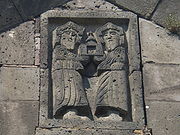
Armenian Apostolic Church
The Armenian Apostolic Church is the world's oldest National Church, is part of Oriental Orthodoxy, and is one of the most ancient Christian communities. Armenia was the first country to adopt Christianity as its official religion in 301 AD, in establishing this church...
monastery
Monastery
Monastery denotes the building, or complex of buildings, that houses a room reserved for prayer as well as the domestic quarters and workplace of monastics, whether monks or nuns, and whether living in community or alone .Monasteries may vary greatly in size – a small dwelling accommodating only...
located in the town of Akhtala
Akhtala
Akhtala a town in Lori Province, Armenia with 2800 inhabitants according to 2009 estimate. It is situated on the left bank of Debed river at adistance of 186 km north of Yerevan and 62 km north of provincial centre Vanadzor on the slopes of Lalvar mountain. Akhtala was a village until 1939 when it...
in the marz
Administrative divisions of Armenia
Armenia is subdivided into eleven administrative divisions. Of these, ten are provinces, known as marzer or in the singular form marz in Armenian....
of Lori, 185 kilometres (115 mi) north of Yerevan
Yerevan
Yerevan is the capital and largest city of Armenia and one of the world's oldest continuously-inhabited cities. Situated along the Hrazdan River, Yerevan is the administrative, cultural, and industrial center of the country...
. The monastery is currently inactive. The fortress played a major role in protecting the north-western regions of Armenia (Gugark
Gugark
Gugark was the 13th province of Greater Armenia. It now comprises parts of northern Armenia, northeast Turkey, and southwest Georgia.-History:...
) and is among the most well preserved of all in modern Armenia. The main church at the compound is famous for its highly artistic frescoes, which cover the inside walls, the partitions, and the bearings of the building. The modern name of Akhtala was first recorded in a royal decree of 1438. The etymology of the name is believed to be of Turkic
Turkic languages
The Turkic languages constitute a language family of at least thirty five languages, spoken by Turkic peoples across a vast area from Eastern Europe and the Mediterranean to Siberia and Western China, and are considered to be part of the proposed Altaic language family.Turkic languages are spoken...
origin, meaning white glade.
The fortress
Between 1887 and 1889 the French archaeologist Jacques de MorganJacques de Morgan
Jean-Jacques de Morgan was a French mining engineer , geologist, and archaeologist. He was the director of Antiquities in Egypt during the 19th century , and excavated in Memphis and Dashur, providing many drawings of many Egyptian pyramids...
discovered 576 rectangular stone sepulchers, along with cultural items made of clay, bronze and iron near Akhtala dating back to the 8th century BC. The settlement of modern Akhtala was known as Agarak in the 5th century. The fortress was almost certainly built on top of Bronze and Iron Age foundations. It was built in the late tenth century by the Kyurikids, this branch of the Bagratunis originated from Gurgen
Kiurike I
Kiurike I was the first king of the Kingdom of Lori. He was succeeded by his son David I Anhoghin.-References:...
(the name was pronounced Kyurikeh in the local dialect of Gugark). He was the son of the patrons of Sanahin
Sanahin
Sanahin is a village in the northern province of Lori in Armenia, now considered part of the city of Alaverdi...
and Haghpat
Haghpat
Haghpat is a village in the Northern Lori province of Armenia, close to the city of Alaverdi and the state border with Georgia.It is notable for Haghpat Monastery, a religious complex founded in the 10th century and included in the UNESCO World Heritage List along with monasteries in nearby Sanahin...
monasteries located not far from Akhtala, King Ashot III the Merciful
Ashot III
Ashot III the Merciful also known as Ashot the Gracious was an Armenian king. He ruled from Armenia's capital city of Ani....
and Queen Khosrovanush. Gurgen's brothers were King Smbat II the Conqueror
Smbat II
Smbat II King of Armenia , son of Ashot III and ruled from Ani. He fortified the city and began the construction of the Cathedral of Ani. Smbat II succeeded to Ashot III, and continued his father’s work. He ordered the construction of a wall around the city of Ani and built towers and...
and Gagik I Bagratuni
Gagik I of Armenia
Gagik I was king of the Bagratuni Kingdom of Armenia. He succeeded his brother Smbat II the Conqueror . Armenia reached its zenith during the reign of Gagik.-Rule:...
, under whom the Bagratuni Kingdom of Armenia
Bagratuni Kingdom of Armenia
The medieval Kingdom of Armenia, also known as Bagratid Armenia , was an independent state established by Ashot I Bagratuni in 885 following nearly two centuries of foreign domination of Greater Armenia under Arab Umayyad and Abbasid rule...
reached the peak of its prosperity.
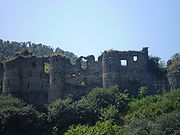
Kingdom of Lori
Kingdom of Lori alternatively known as the Kingdom of Tashir-Dzoraget or Kingdom of Albania, was an Armenian kingdom formed during the breakup of Bagratuni Armenia. The kingdom encompassed territories of modern-day Armenia, Azerbaijan and Georgia....
(Tashir-Dzoraget Kingdom) in Gugark for strategic reasons and enthroned Gurgen in 982. Gurgen along with his brother Smbat are depicted on the sculptures of the patrons in both Sanahin and Haghpat. When the Tashir-Dzoraget kingdom fell as a result of Seljuk
Seljuq dynasty
The Seljuq ; were a Turco-Persian Sunni Muslim dynasty that ruled parts of Central Asia and the Middle East from the 11th to 14th centuries...
raids the Kyurikids migrated to Tavush
Tavush
Tavush is a province of Armenia. The marz of Tavush is located in the north of Armenia and borders on Georgia and Azerbaijan.It is well known for its mountains. The most part of its territory is situated 800-1,000 m above sea level...
and Metsnaberd yet they maintained ties with their ancestral fortress and compound in Akhtala. The fortress was built on an elevated rocky outcrop surrounded by deep canyons from three sides forming a natural protection. The somewhat accessible parts between the cliffs are reinforced by towers and walls. The only entrance to the compound is on the northern side protected by bell-shaped towers and walls. The walls and towers of the fortress are built of bluish basalt and lime mortar. The Kyurikids gradually lost their influence under the Seljuk grasp by the end of the 12th century.
The monastic life was revived in Akhtala when the Zakarids
Zakarid-Mxargrzeli
The Zakarid , also known by their Georgian language moniker as Mkhargrdzeli , were a noble family prominent in medieval Armenia and Georgia. Their name in Georgian, Mkhargrdzeli, or in , meant long-armed. A family legend says that this name was a reference to their Achaemenid ancestor Artaxerxes...
heading the combined Georgian and Armenian forces liberated most of Armenia. The 13th century historians Kirakos Gandzaketsi
Kirakos Gandzaketsi
Kirakos of Gandzak was an Armenian historian of the 13th century and author of the History of Armenia, a summary of events from the 4th to the 12th century and a detailed description of the events of his own days. The work concentrates primarily on the history of Medieval Armenia and events...
and Vardan Areveltsi
Vardan Areveltsi
Vardan Areveltsi was a thirteenth century Armenian historian, geographer, philosopher and translator. In addition to establishing numerous schools and monasteries, he also left behind a rich contribution to Armenian literature...
called the area Pghndzahank (copper mine), because of rich copper deposits in the surroundings. Gandzaketsi writes the following: "Ivane, Zakare's brother, also died [that year] and was buried at Pghndzahank' near the church which he himself had built, taking it from the Armenians and making it into a Georgian monastery."
Pghndzahank became the property of Ivane Zakarian in the 1180s. While Ivane's brother Zakare was Armenian Apostolic, Ivane had accepted Greek Orthodoxy in the Georgian court. Several monasteries in northern Armenia were converted by the Zakarids to Greek Orthodoxy, a prominent example is the monastery of Kobayr. By doing so Ivane enhanced the benevolence of the Georgian court and gained influence among the Chalcedonian
Chalcedonian
Chalcedonian describes churches and theologians which accept the definition given at the Council of Chalcedon of how the divine and human relate in the person of Jesus Christ...
Armenians who mostly inhabited Northern and North-Western Armenia. The Zakarids began to lose control starting in the 1220s during the disastrous Mongol invasions of Georgia and Armenia. The son of Ivane, Avak was forced to recognize his subordination to the Mongol leader Chormaqan
Chormaqan
Chormaqan was one of the most famous generals of the Mongol Empire under Genghis Khan and Ögedei Khan. He was also a member of the keshik....
. The Mongol rule continued until 1340 when it was interrupted by successive conquests of Turkic tribes. The Turkic tribe of Kara Koyunlu
Kara Koyunlu
The Kara Koyunlu or Qara Qoyunlu, also called the Black Sheep Turkomans , were a Shi'ite Oghuz Turkic tribal federation that ruled over the territory comprising the present-day Armenia, Azerbaijan, north-western Iran, eastern Turkey and Iraq from about 1375 to 1468.The Kara Koyunlu Turkomans at one...
began attacking the Caucasus and took control of most of Armenia proper by 1400. Their rule was interrupted by the conquests of Tamerlane. One of the cliffs that surrounds Akhtala is known as Lenktemur, named after Tamerlane who according to local tradition buried one of his wives under the cliff.
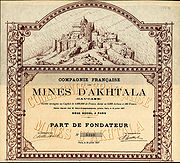
Gümüshane
-Features:Gümüşhane has a rich historical background so there are many historical places, mosques, churches, castles. Ancient city of Satala in the modern village of Sadak was the most important military camp of the ancient Roman Empire in the east. This place was ruled by the Hittites, Assyrians,...
in the Ottoman Empire
Ottoman Empire
The Ottoman EmpireIt was usually referred to as the "Ottoman Empire", the "Turkish Empire", the "Ottoman Caliphate" or more commonly "Turkey" by its contemporaries...
to Akhtala in 1763 by the Georgian King Erekle II
Erekle II
Erekle II was a Georgian monarch of the Bagrationi Dynasty, reigning as the king of Kakheti from 1744 to 1762, and of Kartli and Kakheti from 1762 until 1798. In the contemporary Persian sources he is referred to as Erekli Khan, while Russians knew him as Irakli...
. The Greeks called the monastery "Meramani". The Greek miners have left inscriptions on the monastery walls. In the 19th century Akhtala was taken over by the Armenian princely family of Melikov
Melikov
Melikishvili or Melikov was a noble family in the Kingdom of Georgia, and later in the Russian Empire. The family descended from an Armenian nobleman Melik-Nazar who converted to Islam and was enfeoffed with the melikdom of Lori by the Persian shah Abbas I in 1602...
s. Currently the monastery has its pilgrimage days on September 20–21. Armenians, Greeks and Georgians visit the monastery on this occasion. The Ambassador of Greece, Panayota Mavromichali visited the monastery on September 20, 2006. An ore mining and processing plant in Akhtala has been dumping copper mine tailings in the pit below the monastery. This has been classified as a threat to local residents.
Surb Astvatsatsin (Holy Mother of God) church
The main building of the monastic compound is Surb Astvatsatsin (Holy Mother of God) church. The exact date of the building of the church is unknown. It is generally regarded as a 11th-13th century complex, but the current church has been built on an earlier foundation. Kirakos Gandzaketsi mentions that Ivane Zakarian was buried in the church in 1227. Stepanos OrbelianStepanos Orbelian
Stepanos Orbelian was a thirteenth century Armenian historian and the Metropolitan of the province of Syunik. He is known for writing his well-researched Patmut'yun Nahangin Sisakan, or History of the Province of Syunik.-Biography:...
refers to the church in 1216. Modern researchers date the murals within the church to 1205–1216. Princess Mariam, the daughter of Gurgen II
Kiurike II
Kiurike II was the third king of the Kingdom of Lori. He was succeeded by his son David II.-References:...
(Kyurikeh II) made a record in 1188 on the back of a khachkar
Khachkar
A khachkar or khatchkar is a carved, cross-bearing, memorial stele covered with rosettes and other botanical motifs. Khachkars are characteristic of Medieval Christian Armenian art found in Armenia.-Description:...
found in a place called Ayor adjacent to Akhtala which refers to the construction of the Holy Mother of God church at Akhtala. The inscription on the khackar states the following: "I, the daughter if Kyurikeh, Mariam, erected Surb Astvatsatsin at Pghndzahank, those who honor us remember us in their prayers." In 1185 Mariam had constructed the narthex
Narthex
The narthex of a church is the entrance or lobby area, located at the end of the nave, at the far end from the church's main altar. Traditionally the narthex was a part of the church building, but was not considered part of the church proper...
of the main church in Haghpat. According to some local lore, the church was built in the 7th century by Byzantine emperor of Armenian extraction, Heraclius
Heraclius
Heraclius was Byzantine Emperor from 610 to 641.He was responsible for introducing Greek as the empire's official language. His rise to power began in 608, when he and his father, Heraclius the Elder, the exarch of Africa, successfully led a revolt against the unpopular usurper Phocas.Heraclius'...
. Another legend assumes that the church was built in the 5th century by Georgian King Vakhtang I Gorgasali
Vakhtang I Gorgasali
Vakhtang I "Gorgasali" , of the Chosroid dynasty, was a king of Iberia, natively known as Kartli in the second half of the 5th and first quarter of the 6th century. Gorgasali is a sobriquet meaning in Iranian "wolf’s head"...
. There is no reasonable evidence to support either story.
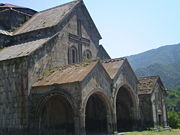
Folklore
Folklore consists of legends, music, oral history, proverbs, jokes, popular beliefs, fairy tales and customs that are the traditions of a culture, subculture, or group. It is also the set of practices through which those expressive genres are shared. The study of folklore is sometimes called...
was used by John the Baptist
John the Baptist
John the Baptist was an itinerant preacher and a major religious figure mentioned in the Canonical gospels. He is described in the Gospel of Luke as a relative of Jesus, who led a movement of baptism at the Jordan River...
to baptise Jesus Christ. Vasak, the father of Prince Prosh, is said to have given this relic to Ivane Zakarian who later sold it for a large sum to the monastery of Noravank
Noravank
Noravank is a 13th century Armenian Apostolic Church monastery, located 122 km from Yerevan in a narrow gorge made by the Amaghu river, nearby the city of Yeghegnadzor, Armenia. The gorge is known for its tall, sheer, brick-red cliffs, directly across from the monastery. The monastery is best...
in Syunik
Syunik
Syunik is the southernmost province of Armenia. It borders the Vayots Dzor marz to the north, Azerbaijan's Nakhchivan exclave to the west, Karabakh to the east, and Iran to the south. Its capital is Kapan. Other important cities and towns include Goris, Sisian, Meghri, Agarak, and Dastakert...
.
The church is situated in the middle of the fortress' territory along the longitudinal axis. It belongs to the domed basilica type of churches, where the bearings join with the side-chapels of the apse. Two pairs of arches divided the longitudinal stretched prayer hall into three naves, the central one of which (with double side-chapels) on the eastern side ends with low staged, half-rounded apse and the side-chapels end with sacristies. They are characterized with stylish iconography, richness of theme and variety of different colors (where blue is dominant). The vertical axis of the building was crowned by a massive dome. The pointed dome with the cylindrical drum has not survived. It was damaged during Tamerlane's invasion and completely demolished in 1784 when the Avar
Caucasian Avars
Avars or Caucasian Avars are a modern people of Caucasus, mainly of Dagestan, in which they are the predominant group. The Caucasian Avar language belongs to the Northeast Caucasian language family ....
Omar Khan invaded the Transcaucasus from Dagestan
Dagestan
The Republic of Dagestan is a federal subject of Russia, located in the North Caucasus region. Its capital and the largest city is Makhachkala, located at the center of Dagestan on the Caspian Sea...
. In the 19th century, Viceroy of the Caucasus
Viceroyalty of the Caucasus
The Viceroyalty of the Caucasus is a term used to denote the Imperial Russian administrative and political authority in the Caucasus region exercised through the offices of glavnoupravlyayushchiy and namestnik...
, Prince Mikhail Vorontsov
Mikhail Semyonovich Vorontsov
Prince Mikhail Semyonovich Vorontsov , was a Russian prince and field-marshal, renowned for his success in the Napoleonic wars, and most famous for his participation in the Caucasian War from 1844 to 1853....
built a semi-spherical wooden dome covered with iron sheets in place of the original dome. The dome was renovated during Soviet years.
Murals of Surb Astvatsatsin

Byzantine art
Byzantine art is the term commonly used to describe the artistic products of the Byzantine Empire from about the 5th century until the Fall of Constantinople in 1453....
art outside the traditional borders of Byzantium. The majority of the murals bare scriptures in Greek. The murals were painted under the patronage of atabek Ivane Zakarian between 1205 and 1216. Parallels have been drawn between the murals and the 11th century Armenian miniature paintings of the Mugni Gospels. The coloring of the murals is characteristic of typical Byzantine art while the thematic solutions are more Armenian. New and Old Testaments scenes as well as various saints including Saint Gregory the Illuminator
Gregory the Illuminator
Saint Gregory the Illuminator or Saint Gregory the Enlightener is the patron saint and first official head of the Armenian Apostolic Church...
are depicted on the murals. A large image of the Holy Virgin is depicted in the dome holding Jesus. The mural has been badly damaged and only parts of it survived. Below the Holy Virgin, the Communion is shown where Jesus is depicted twice, turning on the right and left sharing bread with the Apostles. The images of the Apostles Peter
Saint Peter
Saint Peter or Simon Peter was an early Christian leader, who is featured prominently in the New Testament Gospels and the Acts of the Apostles. The son of John or of Jonah and from the village of Bethsaida in the province of Galilee, his brother Andrew was also an apostle...
, John the Evangelist
John the Evangelist
Saint John the Evangelist is the conventional name for the author of the Gospel of John...
, Paul and Matthew
Matthew the Evangelist
Matthew the Evangelist was, according to the Bible, one of the twelve Apostles of Jesus and one of the four Evangelists.-Identity:...
have survived. The common Christians saints are depicted below the Communion scene, including Pope Sylvester, Saint James
James, son of Alphaeus
Saint James, son of Alphaeus was one of the Twelve Apostles of Jesus Christ. He is often identified with James the Less and commonly known by that name in church tradition....
the son of Alpheus
Alphaeus
Alphaeus is mentioned in the New Testament as the father of two of the Twelve Apostles, namely:*Matthew Levi the Apostle*James, son of AlphaeusThere may have been two separate men named Alphaeus...
, Saint John Chrysostom
John Chrysostom
John Chrysostom , Archbishop of Constantinople, was an important Early Church Father. He is known for his eloquence in preaching and public speaking, his denunciation of abuse of authority by both ecclesiastical and political leaders, the Divine Liturgy of St. John Chrysostom, and his ascetic...
, Basil the Great, Gregory the Illuminator
Gregory the Illuminator
Saint Gregory the Illuminator or Saint Gregory the Enlightener is the patron saint and first official head of the Armenian Apostolic Church...
, Jacob of Mtsbin, Clement of Rome, Gregory the Thaumaturgist
Gregory Thaumaturgus
Gregory Thaumaturgus, also known as Gregory of Neocaesarea or Gregory the Wonderworker, was a Christian bishop of the 3rd century.-Biography:Gregory was born at Neo-Caesarea around 213 A.D...
, Cyril of Alexandria
Cyril of Alexandria
Cyril of Alexandria was the Patriarch of Alexandria from 412 to 444. He came to power when the city was at its height of influence and power within the Roman Empire. Cyril wrote extensively and was a leading protagonist in the Christological controversies of the later 4th and 5th centuries...
and Eusebius of Caesarea
Eusebius of Caesarea
Eusebius of Caesarea also called Eusebius Pamphili, was a Roman historian, exegete and Christian polemicist. He became the Bishop of Caesarea in Palestine about the year 314. Together with Pamphilus, he was a scholar of the Biblical canon...
. The murals on the western wall depict the Kingdom of Heaven
Kingdom of God
The Kingdom of God or Kingdom of Heaven is a foundational concept in the Abrahamic religions: Judaism, Christianity and Islam.The term "Kingdom of God" is found in all four canonical gospels and in the Pauline epistles...
. The northern wall depicts the trial of Jesus by the high priest of Caiaphas
Caiaphas
Joseph, son of Caiaphas, Hebrew יוסף בַּר קַיָּפָא or Yosef Bar Kayafa, commonly known simply as Caiaphas in the New Testament, was the Roman-appointed Jewish high priest who is said to have organized the plot to kill Jesus...
and by the Roman Procurator
Roman governor
A Roman governor was an official either elected or appointed to be the chief administrator of Roman law throughout one or more of the many provinces constituting the Roman Empire...
Pontius Pilate
Pontius Pilate
Pontius Pilatus , known in the English-speaking world as Pontius Pilate , was the fifth Prefect of the Roman province of Judaea, from AD 26–36. He is best known as the judge at Jesus' trial and the man who authorized the crucifixion of Jesus...
. Some of the murals were renovated in 1979. The arches, niches and columns are also covered by murals.
Other structures
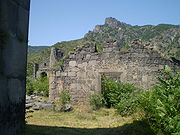
Known residents
Inscriptions from nearby khachkars point out that the monastery was headed by Petreh in the 1240s. The most prominent figure who resided at the monastery was the translator and scribe Simon of Pghndzahank. His diaries have survived. He was born in 1188 and was a clergyman for several years at the monastery translating Byzantine theological literature. He collaborated with another Armenian of Chalcedonian faith, Minas Syunakyats of TrabzonTrabzon
Trabzon is a city on the Black Sea coast of north-eastern Turkey and the capital of Trabzon Province. Trabzon, located on the historical Silk Road, became a melting pot of religions, languages and culture for centuries and a trade gateway to Iran in the southeast and the Caucasus to the northeast...
. In 1227 Simon compiled a volume of works by Gregory of Nyssa
Gregory of Nyssa
St. Gregory of Nyssa was a Christian bishop and saint. He was a younger brother of Basil the Great and a good friend of Gregory of Nazianzus. His significance has long been recognized in the Eastern Orthodox, Oriental Orthodox, Eastern Catholic and Roman Catholic branches of Christianity...
. His diary reads:
Simon also translated into Armenian the Elements of Theology by Proclus Diadochos
Proclus
Proclus Lycaeus , called "The Successor" or "Diadochos" , was a Greek Neoplatonist philosopher, one of the last major Classical philosophers . He set forth one of the most elaborate and fully developed systems of Neoplatonism...
, The Fountain of Wisdom by John Damascene
John of Damascus
Saint John of Damascus was a Syrian monk and priest...
, The Ladder of Divine Ascent
The Ladder of Divine Ascent
The Ladder of Divine Ascent, or Ladder of Paradise , is an important ascetical treatise for monasticism in Eastern Christianity written by John Climacus in ca...
by John of Sinai
John Climacus
Saint John Climacus , also known as John of the Ladder, John Scholasticus and John Sinaites, was a 7th century Christian monk at the monastery on Mount Sinai. He is revered as a saint by the Roman Catholic, Oriental Orthodox, Eastern Orthodox and Eastern Catholic churches.We have almost no...
, A History of Georgia (Kartlis Tskhovreba) and The Greek Prayer Book. Simon also noted in his diaries that he only translated works which previously had not been translated into Armenian. The prominent Armenian filmmaker of the 20th century Sergei Parajanov filmed two episodes of his film The Color of Pomegranates
The Color of Pomegranates
The Color of Pomegranates is a 1968 Armenian film directed by Sergei Parajanov.-Overview:The Color of Pomegranates is a biography of the Armenian ashug Sayat-Nova that attempts to reveal the poet's life visually and poetically rather than literally...
at the monastery.
Further reading
- Lidov A.Alexei LidovAlexei Mikhailovich Lidov is a Russian art historian and byzantinist, an author of the concept hierotopy.- Life and career :...
, Murals and the art of the Armenian Chalcedonites, "History of the Ancient and Medieval World" - Akhtala, Soviet Armenian Encyclopedia, vol. 1, Yerevan, 1974
- Melikset-Bek L., The Georgian Sources on Armenia and the Armenians, vol. 3, Yerevan, 1955
- Jalalian A., Kotanjian N., Surb Astvatsatsin Monastery at Akhtala, "Christian Armenia" Encyclopedia, Yerevan, 2002
- Durnovo L., A Brief History of Classical Armenian Painting, Yerevan, 1957
- Durnovo L., An Outline of Medieval Armenian Art, Moscow, 1979
- Bishop Kirion, Akhtala Monastery, Tbilisi, 2005

